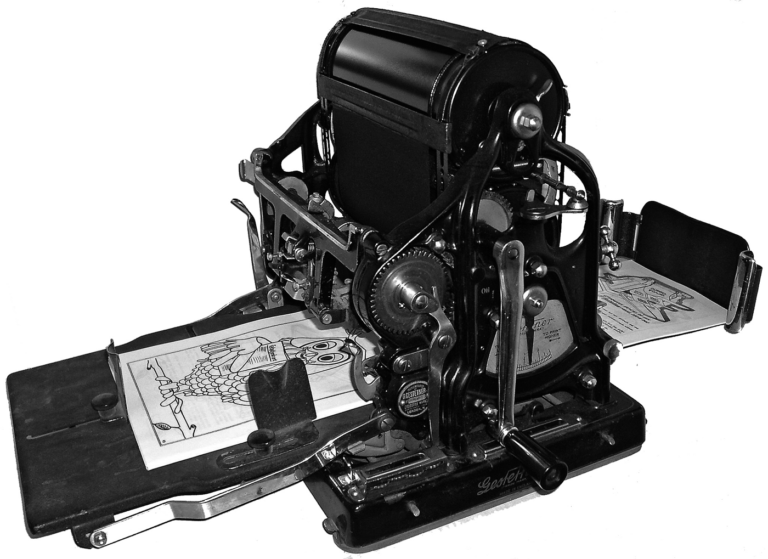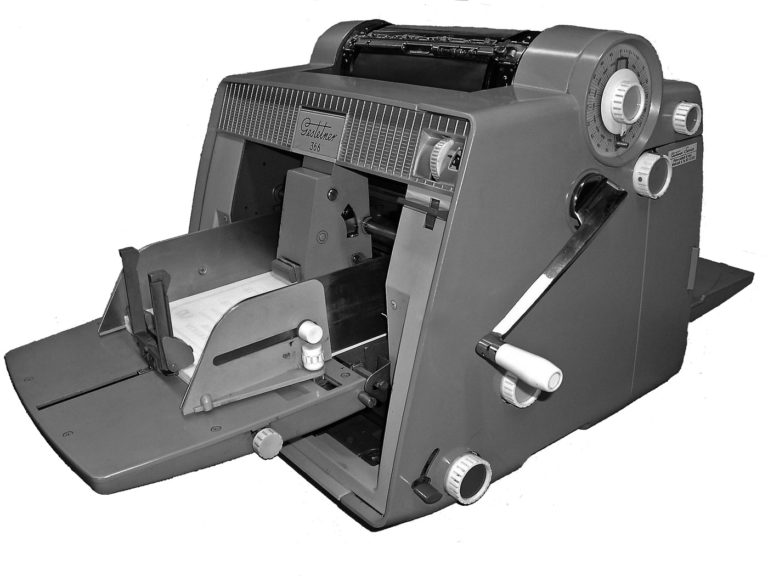E
From the 20th century (circa 1900), there were two types of equipment in use: In addition to single-drum machines there were also two-drum machines. The one-drum devices could, even if one does not suspect it, print multicolored by the fact that the color drums were interchangeable—in the lower cabinets of the devices the unused inking units could be stored. In 1910, 200,000 mimeographs were in operation, by 1940, this number rose to 500,000. In his publication “Office Duplicating,” which was printed on a mimeograph by A. B. Dick in 1939, George H. Miller wrote: “There is little doubt that stencil duplicating in America owes its rapid and widespread growth to the Mimeograph machines and stencils as developed by the A.B. Dick Company.”
In 1923, the spirit duplicator was invented by William Ritzerfeld, and distributed as “Ditto machine” in the USA, “Banda machine” in the United Kingdom or “Roneo” in France and Australia. The term “spirit duplicator” was used because because it refers to the alcohols which were needed as major component in the solvents that were used as “inks” within the machine. In order to duplicate an original, first of all, as with all other methods, a template was made. In this case a sprit master or master sheet could be typed, drawn, or written upon. This color-treated master was placed on a special foil containing an alcohol-soluble wax that had been impregnated with one of a variety of colorants. The pressure of writing or typing on the first sheet transferred the colored wax from the second sheet to the shiny/coated back side of the first sheet, producing a mirror image. This produced the same result of a sheet of carbon paper put in backwards. The two sheets were then separated, and the first sheet was fastened onto the drum of the machine, with the back side facing out, acting as a printing plate. There is no separate ink used in spirit duplication, as the wax transferred to the back side of the first sheet contained the ink. As the paper to be printed moved through the printer, the solvent was spread across each sheet by an absorbent wick. When the solvent-impregnated paper came into contact with the back side of the first sheet, it dissolved just enough of the pigmented wax to print the image onto the paper as it went under the printing drum.
As with mimeographs and later risograph printers, the quality of the prints was rather limited, and the use of documents printed with the spirit printer was severely limited in time as the color of the prints quickly faded. Thus, this method was not suitable for archival purposes. The costs were very low and the spirit printer was therefore used by schools, associations, churches and other smaller organizations for printing, also because of the usable, very inferior and thus cheap paper. Spirit printers, like the other duplication methods, gradually began to be used less frequently and were eventually retrieved in 1970 and replaced by the more favorable and higher-volume printing process of Xerography .
 1
The Gestetner Ream, circa 1920
1
The Gestetner Ream, circa 1920
 2
The Gestetner 366, circa 1960; both pictures owned by Erwin Blok
2
The Gestetner 366, circa 1960; both pictures owned by Erwin Blok


